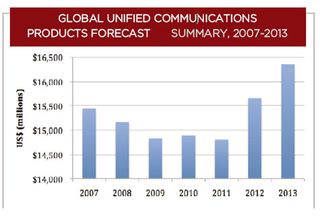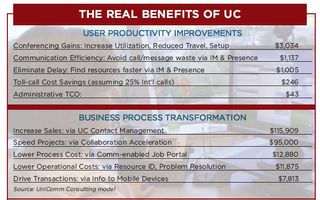Go to any tech conference these days, and you'll find that the most popular sessions are focused on the current industry buzzword "unified communications" (UC). But what exactly is it? Voice communication equipment manufacturers such as Cisco, Avaya, Nortel, NEC, and Siemens are pushing UC offerings, but so are vendors not traditionally associated with voice or video, including IBM, Microsoft, RIM, and even applications suppliers such as SalesForce.com. Surveys routinely find that most large enterprises are investigating or deploying UC
functionality, and many medium-sized businesses are too.
One good definition of unified communications is "communications integrated to optimize business processes." That succinct, six-word definition does a great job of capturing the essence of this rapidly developing idea, but it's helpful to understand it in a broader context.
The critical, long-term driver spurring UC adoption is the communications industry's seismic shift from being vertically integrated to becoming horizontally layered. Three decades ago the data processing industry went through a similar transformation. Layered architectures with standards and open interfaces between different components emerged. This spawned a new industry - thousands of developers and companies emerged to create innovative software applications. That led to the revolution that has seen computer processors become a critical component in virtually every aspect of modern life.
We are in the process of transforming the communications industry in a similar way, with layers, standards, and an ecosystem of business partners, applications developers, and systems integrators. This transformation will bring widespread changes in both business and personal communications. As before, there will be emerging communications products and capabilities, and legions of developers and products, but more important, there will be new ways of thinking about how communications helps get things done. These changes are driving unified communications concepts and capabilities. And UC is changing the way communications works in business.

Source: Wainhouse Research contact. Increasingly, presence information will be updated automatically by other business applications, and this information will be shared among multiple presence servers within companies and between servers in different companies. Finally, rules and policy engines tune presence data to provide appropriate accessibility information, while managing security and privacy concerns. The promise of UC is that it facilitates timely communications between people, and timely access to information.
These capabilities support two broad ways to use unified communications. The first "use case" is all about individual productivity, helping individual users manage their communications more effectively. Users can easily grasp the concept of hovering over a name in an email or selecting an appropriate resource from a list, right-clicking to determine availability, and instantly launching a communication.
The second type of UC implementation is a little more complex. It involves integrating communications functionality into business processes to change how work gets done. Rather than just focusing on individual productivity, this use concentrates on removing communications bottlenecks to accomplish business goals more efficiently and effectively. Often, this means building communications functionality and accessibility directly into business applications software to streamline workflows.
IMPLEMENTING UC APPLICATIONS
Opportunities for both major UC use cases - individual user productivity (UC-U) and transforming business processes (UC-B) - exist in most enterprises. UC-U concepts are easier to understand and deploy. Once users understand presence-based communications access, many expand their usage to incorporate conferencing and collaboration functions. Starting with user productivity applications often builds acceptance and understanding among user communities.
The steps to add UC-U functionality can be straightforward, depending on the existing environment and the capabilities that are needed. They include [1] acquiring the needed central servers that manage the UC applications, [2] buying the licenses, [3] installing client software on the user's devices, and [4] training.
The UC-B use cases start with the same capabilities and functionalities, but organizes them around changes in business process and streamlining business activities. Frequently, groups of employees follow a process controlled by a workflow system or an information portal. Communications bottlenecks can occur because someone in the process needs information or approvals from someone else. UC can minimize disruptions in these situations. In some cases, communications functionality can be incorporated directly into the workflow or process or portal application software.

Unified Communications can deliver cost savings resulting from individual user productivity, but when implemented as part of a total business process transformation, the benefits can be significantly greater. individual; it's looking for a particular skill set. This technique - looking for skills rather than specific individuals - is one difference in how UC-B and UC-U opportunities are often deployed.
A good place to start is to identify communications bottlenecks throughout an enterprise's value chain (see sidebar, "Impacts and Benefits"). Five UC-B opportunities are common in many organizations: contact management, resource identification for problem resolution, collaboration acceleration, information for mobile workers, and job-specific communications portals.
Successful companies often deploy two additional ways to help spread the UC concepts. First, they identify and provide extra information and training to individuals who then help others within their departments. Second, users begin to incorporate UC functionality into how they accomplish many of their business process communications functions.
In today's economic environment, measuring the benefits and building a solid justification case is critical. There are clear benefits from implementing UC, but it's important to tailor them to the company's specific applications and use (see sidebar, "The Real Benefits of UC"). We've found that the benefits from business process transformation are often ten times greater than the benefits from individual user productivity. Moreover, while the UC-U productivity benefits may be available, they are frequently harder to build into a convincing business case.
If the benefits are greater, why don't all enterprises seek business process transformation? Many organizations find it easy to understand the concepts behind in the benefits of individual productivity from UC-U. But transforming business processes through integrated communications requires analysis of business workflows and commitment by management and staff to change processes to achieve the benefits. Process change is always more challenging, even though the benefits are greater.
A DYNAMIC MARKETPLACE
One of the effects of transforming communications from being vertically integrated to horizontally layered is the appearance of new types of suppliers in the market. In the past, the legacy telephony suppliers dominated the market for "voice communications." Email brought new suppliers that offered mobility (like RIM, Nokia, etc.) and desktop applications (like IBM and Microsoft, etc.). More recently, applications vendors and portal providers are building communications functionality into their products (such as Salesforce.com and Oracle).
As communications capabilities converge, these suppliers are expanding their offers and encroaching on what had been others' "territory" (see sidebar, "UC Suppliers focus on different segments"). Increasingly, many different kinds of suppliers from many different market sectors are providing a full range of UC functionality through their own development work, through partnerships, or through OEM arrangements.
Which supplier should be the focus of your deployment? If phone calls provide the primary means of internal communications, your PBX supplier may provide the best result. Or, if most staff work is focused on computers or mobile devices, then those suppliers may provide the best applications. Alternatively, if key communications are associated with application software or a web portal interface, then those applications could be primary.
Of course, all of these will occur to some degree in most organizations, and therefore the right answer may be to incorporate a variety of UC applications. However, current systems are just getting around to passing presence information to other environments. The current state of UC is like the email islands that existed several decades ago. Sending email between different systems initially was not possible until gateways were developed, and finally universal standards made email ubiquitous. We are in going through a similar progression in presence interoperability. Progress on integration is being made, but in the meantime, careful planning is required to determine who needs to communicate with whom.
IS NOW THE RIGHT TIME FOR UC?
With the current economic climate, some enterprises are postponing investment and cutting back on new initiatives. While that's understandable, times like these can be excellent opportunities for strong companies to extend their market share and to transform processes to provide advantages that will pay off for years into the future. In some companies, UC implementation can bring immediate cost-benefits and help conserve cash. One example is by replacing outside conferencing services with UC-powered solutions, a change that, in many cases, can pay for an entire implementation.
Other companies can improve customer responsiveness or reduce cycle times through better internal communication and collaboration. UC-B solutions have delivered demonstrable ROI or dramatic differences in first-call resolution and similar measures related to customer loyalty. Companies seeking to extend their reach during a down economy find these kinds of solutions very attractive.
Some companies are in a situation in which they have to replace existing systems that are out-of-support or end-of-life. Too often, companies spend millions to swap one telephone set for another and require users to learn new ways to do old tasks - not a prescription for great user acceptance. In these cases, the added functionality through UC capabilities often gives users tangible benefits and a sense of "something new" that help bring users along into the new environment.
Perhaps none of these apply to your company. For some enterprises, the immediate reaction to this economic environment has been to conserve cash, and curtail any non-critical capital expenditures. In those cases, the present is the right time to plan for the future. The seismic shift in the nature and role of communications in the future means that companies will be adjusting to different concepts, deploying different infrastructures and systems, and getting business done in new and different ways. Unified communications will be at the heart of some of these changes.











